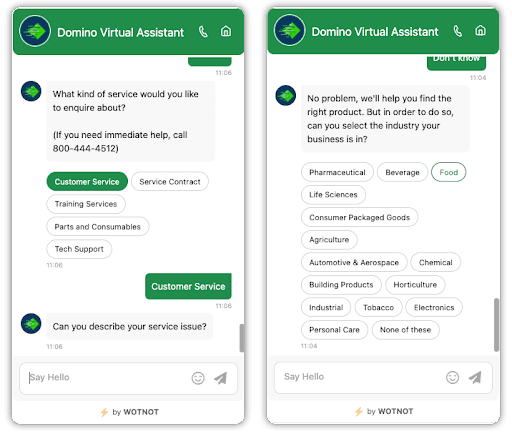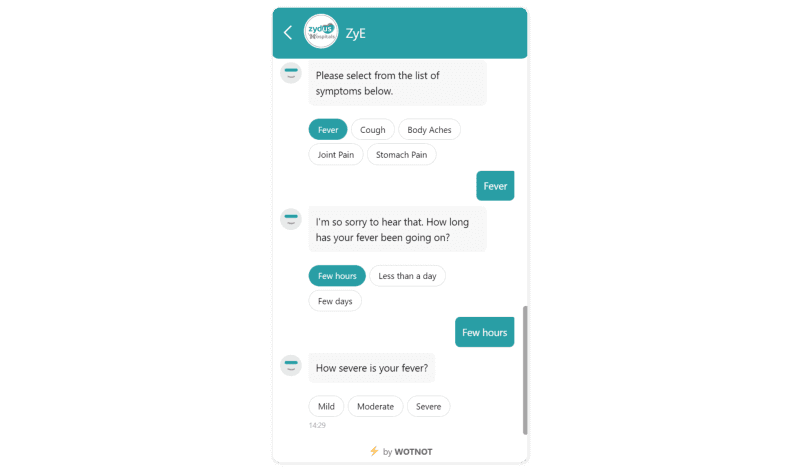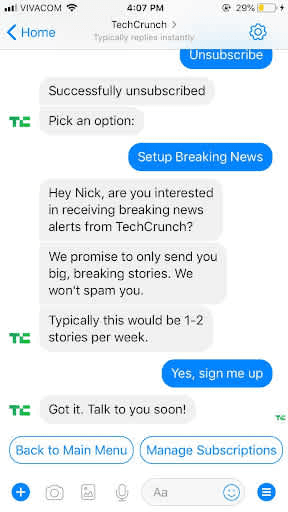Chatbot /
7 Min read
7 Effective Chatbot Use Cases Across Industries [+ Examples]
November 16, 2022

Bhavyadeep Sinh Rathod
Content Editor, WotNot
Just a few days back, I searched for a musician on Google and landed on their website.
Surprisingly, I was greeted by a chatbot.
The bot embodied the name of the musician and was programmed to help the user to navigate, interact with them, and provide behind-the-scenes information about any of the musician’s songs.
The bot was direct about its nature of being a virtual digital assistant but the script was highly interactive and conversational.
It definitely felt like the first of its kind.
Although the number one chatbot use case is “getting a quick answer in an emergency” it made me wonder how many unexplored chatbot use cases are out there and how innovatively brands and individuals are leveraging a chatbot.
Chatbots have evidently advanced and with numerous types of chatbots and feasible chatbot pricing modules, more companies are embracing the technology like never before.
I went on a spree, exploring real-life use cases for chatbots and how different companies are addressing their pain points or simply engaging with site visitors.
Listed below are some of the top case studies of chatbot use cases I came across.
Check them out.
#1 Lego: An Online Retail Toy Company Drives Sales Growth Through Ecommerce Chatbot
Today, finding new target customers on an online platform is not a cakewalk. A lot of eCommerce providers are relying on conversational commerce techniques that involve amplifying their sales and support via a chatbot.
Conversational commerce combines the best of both worlds where it leverages the ease and efficiency of eCommerce portals and the personalized assistance that users would otherwise receive in a brick-and-mortar store.
It’s what one of the largest toy companies in the world did. Lego already had a great offline market. But to transit into the online world and increase its sales was not something they were accustomed to.
Moreover, they identified a pattern in their target market where their toys weren’t just bought for kids but also for adults who bought lego for nostalgia reasons. Hence, their target market comprised adults buying lego products for themselves and for others as gifts but didn’t know where to start.
How Did Chatbots Help?
Enter Ralph — their virtual digital assistant.
To cater to their market, they deployed Ralph, a messenger chatbot that provided product recommendations based on users’ tastes and preferences.
Ralph helped users find the right Lego set and just this simple addition gave them overwhelming success.
This direction also helped Lego earn 3.4 times higher return on ad spend for click-to-Messenger ads. The chatbot cost was also considerably lower than ads which helped them fetch a good ROI.
#2 Domino Printers: A Manufacturing Company Generates Qualified Leads and Business Value
While a lot has been said about how chatbots benefit the customer and are pioneers of sales in the B2C business scenarios, use cases for chatbots in manufacturing had largely been kept in the dark. But you’d be surprised at how many manufacturing companies are taking the assistance of a chatbot.
Manufacturing chatbots are often overwhelmed by the support tickets and managing workflows that span different floors and shifts.
Chatbots bring about the much-needed streamlining in the industrial processes and mundane tasks that its workforce would otherwise have to fulfill manually.
That brings us to our next example.
Domino Printers is a leading company in the commercial printing sector and its reasons for deploying chatbots spanned from digitizing support and generating leads during the turbulent time of the pandemic. As a result, it deployed a bot for both customer support and lead generation.
How Did Chatbots Help?
As for lead generation, the Domino Printers chatbot showcased its 50 products on a carousel so its prospective customers can easily browse the products.
They made it possible through an Airtable integration that made it easy to add or remove products all through a no-code bot builder and an easy-to-use interface.
For customer support, the bot was designed to collect tickets relating to current products, training services, etc. Once the bot raised the ticket, it would automatically get transferred into its CRM.

As a result of this endeavor, Domino Printers was able to:
Scale its engagement by 60%,
Generate a $1.25M attributed pipeline
Solve more than 130 service tickets.
Not so bad for a manufacturing company, isn’t it?
#3 Luxury Escapes: A Travel Company Offers Personalized Travel Packages to Users
The success of the travel industry relies on the number of bookings. Besides, most activities in the travel industry need to contend with customers arriving, leaving, planning and executing. The smoother these processes are, the better.
Being highly service oriented, a travel company also needs to provide top-notch support.
But enhancing the customer experience in travel has always been a challenge. The evolving expectations of customers require brands to provide round-the-clock support and assistance throughout the entire booking journey.
This was what Luxury Escapes was looking for. An Australian global travel company experienced over 2 million website visitors monthly. The visitors would surf for new deals and tour packages, but the journey lacked the personal touch.
The conversion ratio was not up to the mark and the revenue suffered. The marketing efforts didn’t pay off since the number of visitors was not doing anything for the business.
How Did Chatbots Help?
Luxury Escapes deployed a lead-generation AI chatbot that conversed with every website user and enhanced their site experience. The chatbot also came with additional features pertaining to travel industries.
It included a holiday planner that customers could use to design their holiday packages and a product recommendation engine that would recommend packages best suited for individuals after asking a few questions.
Moreover, to further enhance engagement, the chatbot also included a roll-the-dice game for users for the purpose of suggesting random travel destinations. The game proved to be a huge success since it was played 6800 times in its three-month campaign.
#4 Zydus: A Multi-specialty Hospital Schedules Appointments at Scale
Recently, the healthcare industry has experienced an unbearable burden. Globally, hospitals are understaffed and the raging pandemic and other diseases are prompting them to work overtime.
The Healthcare industry has never shied away from embracing new technology that helps reduce their burden and automate key tasks. As healthcare organizations offer increasingly better care and improve health outcomes, AI is playing a central role in the current advancement of the industry and paving the way for numerous healthcare chatbot use cases.
Healthcare chatbots aren’t just systems designed to interact with customers and patients. One of their strengths also lies in the fact that they can be highly competent in internal roles when exposed to different training data. They can book appointments, and provide answers to basic FAQs before the official diagnosis.
Zydus Hospitals, a multi-specialty hospital in India decided to leverage a healthcare chatbot to increase their appointment booking via their website chatbot.
It further wanted to make its service round-the-clock and provide instant answers to patients. Meanwhile, it also wanted to make the booking processes seamless and it knew that the only way it could achieve everything at once would be via a chatbot.
How Did Chatbots Help?
Since India is a multi-lingual country, the first thing Zydus did was build multi-lingual chatbots to reach a larger audience. The chatbot would automate the first part of a doctor-patient interaction, which is, diagnosing the disease.

The chatbot would ask a series of questions and prompt the patient to book an appointment. After this, all the doctor has to do is evaluate the answers and suggest a treatment plan.
As a result of this project, Zydus hospitals were able to:
Handle more than 88k conversations,
Book more than 5k appointments,
Generate business revenue of more than $276K
#5 Royal Bank of Canada: A Global Bank Leverages a Digital Banking Assistant
Banks and the insurance industry strives for services that are meaningful and personal. But with growing customers, it becomes difficult to scale while also keeping their experience intact.
Besides, the future of banking needs to fulfill the demand and walk in the shoes of tech-savvy customers. To address the technological challenges and gaps, financial institutions are implementing AI, insurance chatbots, and banking chatbots to facilitate conversations with millions of customers at once.
Banking chatbots can proactively alert customers to make pending payments, and check out the latest offers on credit cards, and potential upgrades and issues with their bank accounts.
Tasks that used to be completed by talking in a branch or on the phone, are replaced by conversations on a bot interface with virtual assistants for support in real-time.
Canada’s largest bank, the Royal Bank of Canada is following the path to AI automation through chatbots. Over time, it has rolled out AI-powered solutions through NOMI (dubbed from ‘know me’) that have given them a competitive edge.
How Did Chatbots Help?
The bank uses NOMI to send alerts and reminders to account holders. It sends them personalized insights based on their banking history and habits. The chatbot is available on the bank’s mobile app, hence it allows them to manage their daily spending and calculate their budget.
NOMI is also multilingual and smart enough to transfer the chat to a live agent as and when needed. Even though the bot can handle 75% of the questions, it seamlessly transfers to a human if the user wants answers to more personal and complex questions.
#6 AMTRAK: A Train Company Facilitates Online Ticket Booking via a Chatbot
As mentioned, online booking has become the new normal, be it for saloons, travel, hospitals, and other service-based industries. The speed and convenience that automation provides in the online booking are unmatched by the manual process.
As one of the largest rail companies in the US, AMTRAK witnesses thousands of visitors every day. They have more than 20,000 employees and 30 million passengers a year.
AMTRAK was facing the same issues that most face in the travel and service industry today — shortage of customer service staff and increasing customers.
How Did Chatbots Help?
What AMTRAK did is pretty simple. It deployed a messenger chatbot called ‘Julie’ that helps site visitors plan vacations by themselves, book reservations at hotels, navigate the site, and get route information.
The chatbots made three things possible for AMTRAK
Offered a medium for post-sale support
Provided live chat only when needed
Promoted self-service for its thousands of visitors
Julie was programmed to act as the company’s 24/7 customer service representative and currently answers more than 5 million questions per year.
As a result of this, the company witnessed a 25% increase in its bookings, and its booking through chatbots generated 30% more revenue.
#7 TechCrunch: A Technology News Company Pushes the Latest Stories Through a Conversational Marketing Tool
What could possibly be the chatbot use case for an already successful web-based technology news company?
TechCrunch entered the chatbot game early on and implemented them with one core focus — to increase the customer’s brand experience.
It wanted to circulate its content in a better way and make it available to users whenever they needed it.

How Did Chatbots Help?
TechCrunch’s custom chatbot allowed users to pick the number of times they’d like to receive new content and filter them based on the type of content, the authors, etc.
Since TechCrunch has a lengthy directory of content, it facilitates users to customize the experience based on their preferences. Naturally, it drove engaged traffic to the site and laid the foundation for long-term customer relationships.
Finishing Thoughts
The list can be endless if we talk about how bots helped brands achieve the greatest heights of success. But the truth is, we’ve barely scratched the surface when it comes to chatbot use cases. As bot technology progresses, it can do a lot more for brands and customers alike.
All in all, bots are a good topic of discussion. If you’re looking to get educated about them in detail, feel free to contact us, and we can take you on a bot-i-ful journey and help you understand its use cases in depth.
ABOUT AUTHOR
Bhavyadeep Sinh Rathod
Content Editor, WotNot
He likes technology, chatbots, comedy, philosophy, and sports. He often cracks hilarious jokes and lightens everyone's mood in the team.



